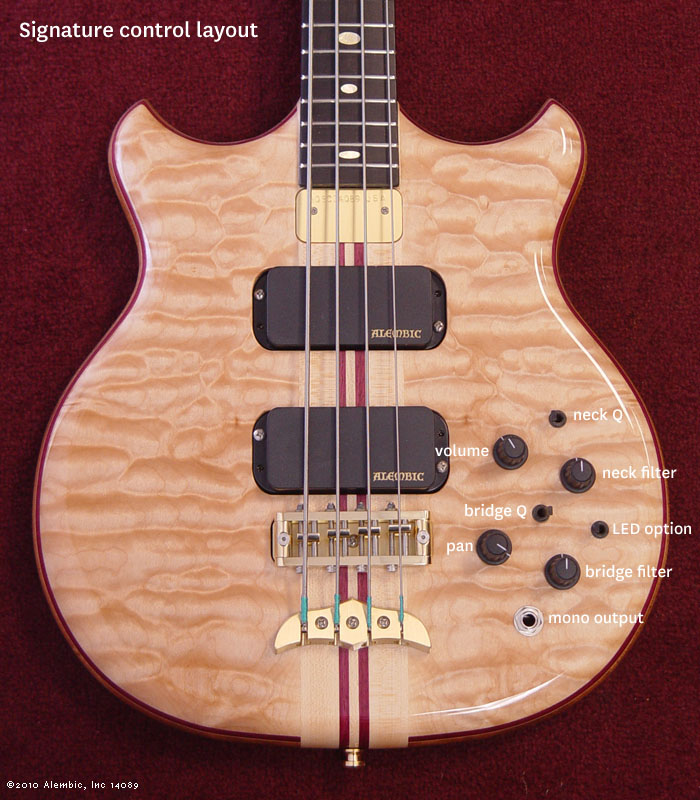| Author | Message | ||
| davehouck
Moderator Username: davehouck Post Number: 1330 Registered: 5-2002 |
Signature controls are volume, balance, neck pickup filter, neck Q switch, bridge pickup filter, and bridge Q switch. Basically, the filter control is a low pass filter; as you roll it back it lowers the point at which it passes low frequency signals and blocks high frequency signals. To quote Mica, "the range is from 350Hz-6KHz. Wherever you set the filter, only frequencies below that cutoff point are passed." The Q switch works in concert with the filter and provides an 8db boost at the cut off frequency you've set with the filter. When the switch is off you get a flat response up to the filter setting. Again to quote Mica, "the Q affects mainly the attack portion of the note". | ||
| mica
Moderator Username: mica Post Number: 6869 Registered: 6-2000 |
 | ||
| mica
Moderator Username: mica Post Number: 7506 Registered: 6-2000 |
The controls affect each pickup separately, so start with the pan control in the center “click” position so you know that there is signal coming from each pickup. When the low-pass filter frequency control (“filter” in diagram) is rotated counterclockwise, you hear the “bassiest” sounds since the filter is only passing frequencies lower than about 300Hz. To get mid-range and high frequency information, rotate the control clockwise. At the maximum setting, all frequencies below 6KHz are passed. The lows are still preserved, even when you include the high frequencies. There is one filter for each pickup. There is one Q switch for each filter. The Q switch boosts the frequency you have the filter tuned to. That means if you have it all the way down to 300Hz, and the Q switch is in the on position (down when playing), there will be an 8dB boost right at 300Hz. While the Q switch is on, rotate the accompanying filter back and forth quickly. You should hear a distinct “wah-wah” effect. That’s the sound of boosting the cutoff frequency as you rapidly tune to different cutoff frequencies. Now, just flick the Q switch up and down while sustaining a note. Not much, huh? That’s because the impact of the Q switch is most noticeable on the attack portion of the note. So, play a phrase that you are really good at repeating like a robot, and try it with the Q switch in the on position, and then with the Q switch in the off position. When the Q switch is on, you should hear a more aggressive percussive attack. Have the Q switch on when you play rock or slap, or anytime you want that more percussive attack. Have the Q switch off when you play blues, ballads, anytime that the percussive attack would be unwelcome. So then you have to put this all together. I approach it like this. I first use the pan to favor either the neck (bass) or the bridge (treble) pickup. I mentally think of the pan like a bass and treble control, though it’s not electronically one at all. Once I get my overall sound set by the pickup favor, then I go for the filtering. I first change the filter on the pickup I’m favoring, then I fiddle with the other one. I might need to jump back and forth a bit. At this point, I may have already decided on to Q or not to Q, but if I haven’t already, then I do so. Lastly, I may only move the pan control slightly throughout my playing, keeping the same general “character” to the sound, just changing the bass treble pickup mix. After you are more familiar with them, your approach may differ from mine, but if you follow what I have done, you will at least have a better understanding of the controls and develop your own technique for getting the most out of the bass. |